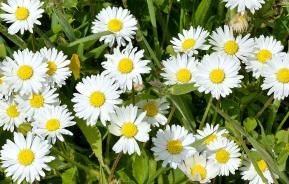Weeds are persistent garden invaders that will often grow back if you fail to treat them correctly. Before you are able to effectively control them you must first be able to identify what type of weed it is, as this will ensure you use the most effective method of removal.
Weeds can be divided into 3 groups which can help determine the best way to identify them:
- Annual weeds
- Lawn weeds
- Perennial and woody weeds

Annual weeds
Annual weeds are the ones that last for one year or growing season only, but which produce lots of weed seeds for next year - and years afterwards.
Use our simple guide to help identify your weed and help you find the ideal product to tackle the job in hand.
Fat hen (Chenopodium album)
The Fat Hen weed is the fastest-growing of all of the annual weeds. There are many different varieties. It is possible for a Chenopodium Album to produce 20,000 seeds in its lifetime just from one single plant. In its baby form, the Fat Hen can be used in salads as it is very tasty but must be monitored carefully in order to prevent the growth across open ground.
Young fat hen weeds have bright green leaves which tend to darken with age and look similar to the image above. The chenopodium album will grow between 2 and 4 feet tall with a vertical stem. This can be difficult to identify for beginners as it can appear in many intermediate forms but the colour and shape of the leaves is the main identifying trait. The lower leaves are usually shaped like a rhomboid whereas the upper leaves would usually appear as a branched stem.
Chickweed (Stellaria media)
Chickweed is one of the most common in the UK. It varies greatly in size and weight and can be found in a multitude of locations including your garden. Like the Fat Hen, the Chickweed's baby form is very tasty and makes a great addition to a salad, as well as being loaded with vitamins. You are advised to disperse of this weed as soon as possible as it attracts Spider Mite and Greenfly which will ruin any edibles you are growing.
Chickweed is most easily identified by its small white star-shaped flowers and tiny white line of weaved hair that grows along the stem. You can expect the Stellaria media to vary in size between 5cm and 50cm with oval-shaped leaves that have pointed tips. The texture of the leaves can vary from smooth to slightly hairy.
Groundsel (Senecio vulgaris)
This weed is capable of being blown in by wind from surrounding areas such as fields or neighbouring gardens, so don't be surprised if it crops up at random. Like most weeds, Groundsel can produce a large amount of seeds, even to the extent that it can produce numerous generations of weed within one growing season.
A groundsel weed is capable of growing up to 2 feet tall with a variety a leaf ranging from lightly hairy with cotton-like hairs to smooth. The stems branch out into little clusters which have small yellow flower heads. The leaves of the Senecio vulgaris are evenly spaced on the stem and have toothed edges.
Hairy Bittercress (Cardamine hirsuta)
A fairly common little weed in the UK often found in areas of bare soil and pathways. Whilst it only grows to a few centimetres high, this little rascal has a hidden talent. The seed pods formed after flowering can explode and disperse the seeds several feet away, so make sure you identify and control this weed well before its flowers set to seed.
Annual Meadow grass (Poa annua)
One of the most common coarse grasses found growing in lawns, flower beds, paths etc. This grass weed is capable of flowering even when the lawn is mown short and the small seed heads can quite easily be seen creating a speckled effect. Annual meadow grass does not like acidic soils, so avoid liming your lawn if you have this grass weed. Sulphate of Ammonia will increase the soil acidity but only use sparingly as other lawn grasses will not like a heavy dose of this.
Yellow oxalis/creeping woodsorrel (Oxalis corniculata)
A low-growing annual weed with bright yellow flowers. The clover-like appearance of the leaves can sometimes lead to mistaken identity. With the stems being able to root where they touch, it doesn’t take this ground invader long to cover a fair-sized area, along with the addition of producing a vast quantity of seed which is thrown out of their seed pods to ensure an even wider spread.
Control
Annual weeds have very simple and shallow root systems, so simply hoeing the tops off or pulling the weeds up will be enough to control them. The roots simply don't have the ability to gather enough energy to re-grow from scratch.
Contact weed killers, usually marketing as working within a few hours, will also be an option. They burn off the top growth of the weed quickly and are often referred to as ‘chemical hoes’. Contact weedkillers don’t get absorbed into the roots, so they are not the best choice for tough perennial weeds.
Whichever method you choose, make sure you remove the weeds before they set seed. Annual weeds spread by sending out vast quantities of seeds so you don't want to let the weeds flower for long!
For annual weeds in the lawn, treat as early as possible with a suitable lawn weedkiller and keep removing the flowers so they cannot seed.








